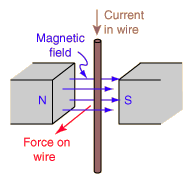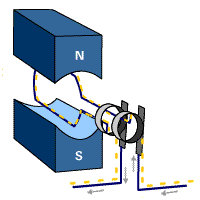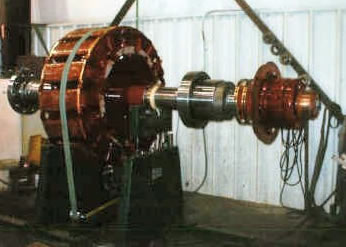|
Electrical current can be generated by
means of moving wire through a magnetic field. This
applies both to alternating current (AC) and direct
current (DC) electricity. This is different than the DC
created by a battery, which uses chemical reactions. It
is also different than static electricity, which is the
accumulation of charges on a surface.
Electrical generators rotate a coil of
wires through a magnetic field. The difference between
an AC and a DC generator is that the AC generator uses
slip rings to transfer the current to the electrical
circuit, while the DC generator uses a split-ring
commutator. Generators can be very small or quite huge.
Very large ones create electricity for the community. An
electric motor is very similar to a generator, except
that power is provided to turn the rotors.
Questions you may have are:
-
What does a wire moving through a
magnetic field look like?
-
How is a loop of wire used in an
electric generator?
-
What do commercial generators look
like?
Moving wire through magnetic field
When a wire made of conducting material
cuts through a magnetic field, an electrical current is
created in the wire.
Note that the wire must be part of an
electrical circuit. Otherwise the electrons have no
place to go. In other words, there is no electrical
current produced with a wire with open ends. But if the
ends are attached to a light bulb, to an electrical
meter or even to each other, the circuit is complete and
electrical current is created.

Moving the wire through the magnetic
field creates an electric current,
as measured by a
meter attached to the ends of the wire
The direction of the magnetic field and
the direction of the wire will determine the direction
of the current through the wire. By convention, the
direction of the magnetic field is from N to S. Also by
convention, the current goes from plus (+) to minus (-).
But note that in reality, the negatively charged
electrons move in the opposite direction than the
current. They move from (-) to (+). You'll just have to
remember that the electrons move in the opposite
direction than the convention for the direction of
current.
Besides moving a wire through a magnetic
field, you could also create an electric current in the
wire by moving the magnets and keeping the wire
stationary.
Another technique to create a current is
to keep both stationary but vary the magnetic field.
That method is used to change the voltage of AC in
electrical transformers. (See AC Transformers for more
information).
Loop is spun
If the wire is made into a loop that is
then spun or rotated in the magnetic field, you can have
continuous current. Since each side of the loop is going
in a different direction in the magnetic field, the
current flows around the loop, depending on which
direction it is rotated.
There must also be some way to transfer
the current to the rest of the circuit. In an AC
generator, having a ring on each end of the wire does
this. A metal contact or brush rubs or slides against
each ring, allowing the electricity to flow through the
circuit. In a DC generator, this is done using one
split-ring called a commutator. An AC generator uses two
slip rings.

Comparison of DC and AC loops and rings
The following animation shows an AC
generator in action. As one side of the loop moves to
the other pole of the magnetic field, the current in it
changes direction. The two slip rings of the AC
generator allow the current to change directions and
become alternating current.

Simple AC generator
In a DC generator, the split-ring
commutator accommodates for the change in direction of
the current in the loop, thus creating DC current going
through the brushes and out to the circuit.
Note that the DC current is not a steady
value. Rather, it is a "bumpy" signal, with zero voltage
at the break in the ring. The power from the current
could be mathematically described as a sine wave
squared. Since most DC generators have many more than
one loop, the "bumps" even out and are not noticed.
The faster the wire passes through the
magnetic field, the greater the current.
Full-sized generators
Instead of having a single loop,
generators used to supply electricity to homes and
businesses have multiple magnets and loops consisting of
wires wound around an iron core, similar to an
electromagnet. The more loops of wire passing through
the magnetic field, the higher the voltage that is
created.

Large generator with multiple windings
Generators used to provide electricity
to the community are huge. The rotor can be well over 10
feet in diameter.
Note that when a generator has its wire
wound around an iron core, it can also be used as an
electric motor. Instead of rotating the loops through a
magnetic field to create electricity, a current is sent
through the wires, creating electromagnets. The outer
magnets will then repel the electromagnets and rotate
the shaft as an electric motor.
If the current is DC, the split-ring
commutators are required to create a DC motor. If the
current is AC, the two slip rings are required to create
an AC motor.
Examine an unplugged electric motor to
see how both a motor and generator looks inside.
Moving wire through a magnetic field
generates electrical current. Electrical generators
rotate a coil of wires through a magnetic field. The
difference between an AC and a DC generator is that the
AC generator uses slip rings to transfer the current to
the electrical circuit, while the DC generator uses a
split-ring commutator. Very large generators create
electricity for the community. An electric motor is very
similar to a generator, except that power is provided to
turn the rotors. |